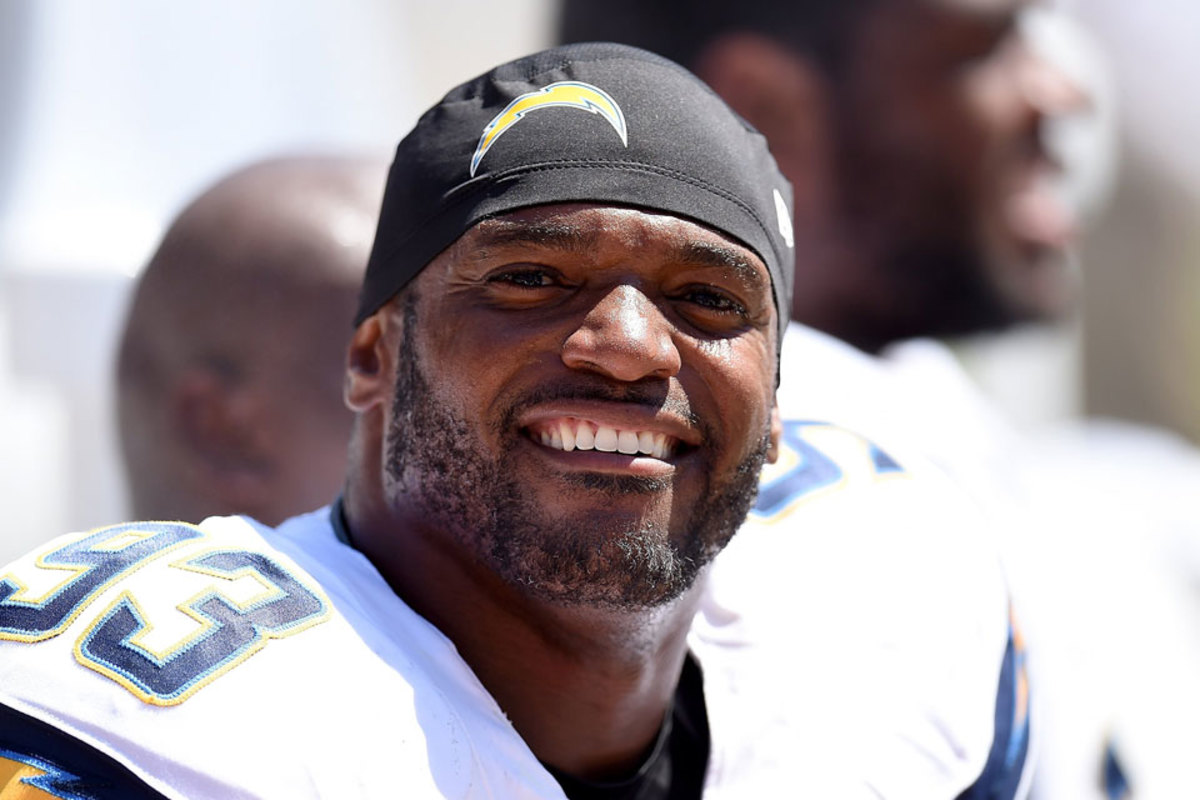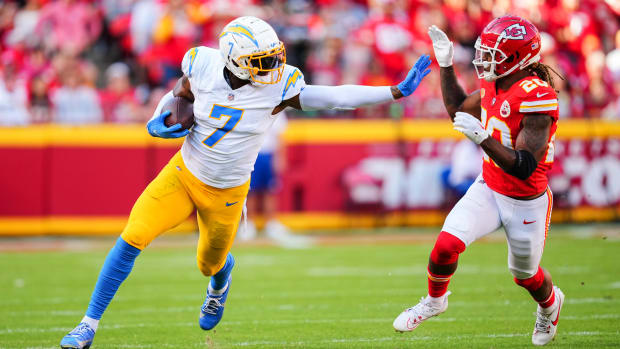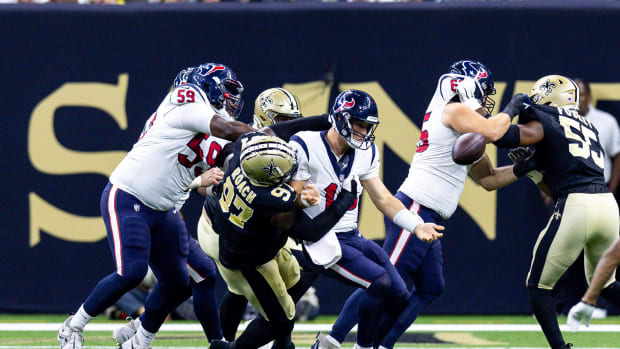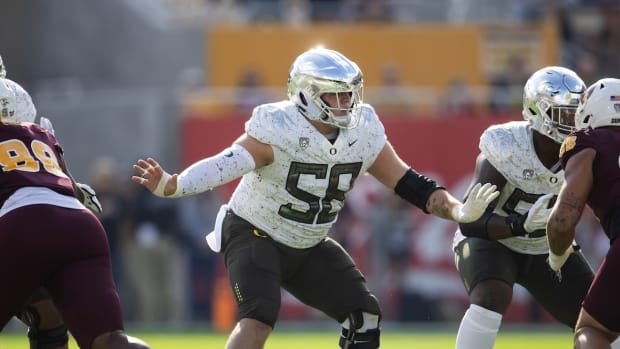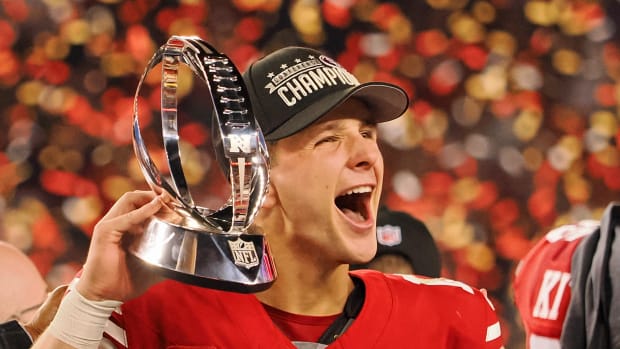Watching Tape With … the Chargers’ Dwight Freeney
First in a series of stories, in which The MMQB goes to school with an NFL player or coach and finds out he studies tape, what he looks at and how such study helps him navigate a complicated game.
SAN DIEGO — In the defensive team meeting room at the Chargers’ training complex a couple of miles north of Qualcomm Stadium, Dwight Freeney is a 34-year-old teacher, not a 34-year-old outside linebacker. That’s how authoritative he sounds, how easily he runs the video on the big screen back and forth, how minute the details he points out.
This offseason, I had an idea about the sport we cover at The MMQB: We spend so much time analyzing how players and teams played, but what about mental preparation? So I decided we would seek out smart people and find out how they watch tape and study their opponents, and we’re starting with a player who gets far too little credit for his brain: Freeney, who has 110 career sacks and is playing at a high level so far in 2014 as San Diego’s most dangerous edge rusher. Among the 48 3-4 outside linebackers rated by Pro Football Focus this week, Freeney is second to only Washington’s Ryan Kerrigan in combined quarterback sacks/hits/significant pressures—Kerrigan has 18, Freeney 16.
“I’m glad we’re doing this," said Freeney, walking into the defensive room with me recently. “People dissect what quarterbacks do and focus on how tough their job is—and it is. But rushing the passer is one of the toughest things to do in sports too. It’s good to let people know how it’s done."
• THE MMQB: Our Film Room columns go deep into X's and O's of football
The tape we decided to watch was the Chargers’ 2013 game against Houston. That would show Freeney primarily squaring off against Texans left tackle Duane Brown—though Freeney does shift to the defensive left side occasionally in San Diego coordinator John Pagano’s scheme, to keep the offense off balance. Because Freeney had matched up against Brown eight times while Freeney was with Indianapolis, he could give me the history of their relationship—and how that history played into this meeting in 2013. In their previous eight meetings, Freeney had 8.5 sacks.
* * *
Freeney, wearing a Yankees cap, sets up shop at the back of the room, behind rows of empty desks where his defensive mates had finished daily meetings earlier. He controls the digital video from a laptop by a mouse, and you can tell pretty quickly he’s used this setup before. Maybe a thousand times. He locates HOU Off v SD Def 2013, and the first quarter of the coaches’ tape launches on the big screen in front of the room.
All week I’ll study a guy," Freeney says. "I’m studying his snaps in the last four preseason games. I’m studying every time I’ve played him. I always keep a film on all the guys that I’ve faced in my career.
He says, “Okay, so you see here that what’s different now a little bit for me is I’m on the left here on this play, and in a minute I’ll be on the right. So it takes a little more preparation. Let me give you an idea of some of the things I’m looking for here. When I get my hand on the ground, the first thing I’m thinking is, Okay, what formation are they in? Because every team has formation tendencies. Prior to the week you have a breakdown. On first-and-10, what kind of plays they like to run. Second-and-seven, third-and-nine, whatever. How long does [quarterback] Matt Schaub like to hold onto the ball? Because they all have tendencies that you especially notice the longer you’ve been studying that team. Based on film study, I'll have a good idea of their concepts, what they’re trying to do.
“The first thing I look at is the personnel. Is it three receivers? Is it two receivers? Is it two running backs? Because that’s all going to determine what they’re trying to do—what types of concepts they’re trying to do from a passing standpoint and a running standpoint. Then the next thing is the defensive call. That's going determine what I’m going to do. Because I might have a game plan in mind—OK, they came out in regular here—21, which is two backs and one tight end. So I’m thinking, Hmm, it might be a run. So I’m gonna settle down. But if they give me a certain defensive call where I have to gear up for a pass, I might have to change some things. So that’s all going through my head."
First snap of the game. Texans' ball, 1st and 10 at their own 15. Freeney is lined up on the left side of the defensive line. For Freeney, the book on Houston and Schaub is that they can throw on first down as much as they run. The right tackle, Derek Newton, looks slightly set back, as if it might be a pass set.
“Based on how they align, I’m guessing pass here. He’s going to show his hand, because the one thing they fear is speed. They fear the fact that I’m a fast guy and they have to hurry up and block me. So they end up tipping their hand to their responsibility or assignment. You would think most guys are like, Okay, we don’t want to tip our hand—just think as an offensive lineman. The offensive coach tells all his linemen, ‘Guys, I want the same stance on runs and passes and play actions, if you can. Because these guys on the other side study too. So if we can get in the same stance every time, they’ll never know if it’s a run or a pass.’
Watching Tape With … the Chargers’ Dwight Freeney
Freeney, lined up on the left side, reads the right tackle Derek Newton’s positioning . . .
. . . and figures pass, since Newton is upright in an attempt to contend with Freeney’s speed.
“But the problem with that is when you get a guy who’s very fast, like me, [the offensive lineman] can’t get in that same stance. Because guess what? I’m gonna run right by you. Screw that. So they tip their hand.
“I'm already geared up for the pass. Now, I know from study on first and second downs, Houston likes to throw quick passes and things of that nature. My responsibility on this particular defense is make sure that I’m outside. So that’s what it was. I go wide, they throw to their left …"
It’s a tipped interception—on the first Houston snap of the game. (A sign of things to come for Schaub, as it turns out.)
Freeney says: “Let’s go to the next play."
First down, next series. Schaub has a long count. Freeney’s lined up outside Brown’s outside shoulder.
“So on this particular play, I already know that it’s a pass. Duane’s set back—he knows it’s a pass. And he flinches. So I’m over here like, Okay, Duane, I know you. I know this is a pass. So he flinches."
Freeney flies off the line, pointing at Brown all the way. A yellow flag flies. “False start, Houston, number 76, five-yard penalty, repeat first down." First-and-15.
Watching Tape With … the Chargers’ Dwight Freeney
Now lined up on the right and facing Duane Brown—whom he’s played against eight times previously—Freeney again reads pass . . .
. . . and immediately jumps when Brown flinches. Brown is flagged for a false start.
“When a guy flinches, always go and always point at his ass," Freeney cackles. “Because they’re gonna have to stop the play. He’s trying to hide it, but I won’t let him. Hell no. You’re not getting away with that. Look at him. He’s like, ‘What? I didn’t do anything!’ Sometimes it’s a hard count, and he actually flinches, then you really can’t go and just run off the ball. But when there’s been no real cadence, and he just does this by accident, go! It isn’t like I jumped offside because I heard something. He just moved. They have to blow the whistle. And I’m pointing at him from the very beginning. I won this one."
Next play: Freeney drops in coverage.
“Full menu for Dwight Freeney in this game—and this is just the third play," I say. “Rush left, rush right, drop with the tight end."
Watching Tape With … the Chargers’ Dwight Freeney
Freeney is deployed in multiple roles in San Diego’s scheme . . .
. . . including dropping into coverage, as he does here from his position on the right side of the line.
“That’s kind of the whole dynamic of what we do here," he says, "which is different—we’re not just going to be a conventional defense. Sometimes zone blitzing and I’m dropping back in coverage. Try to get them in situations where they’ll never expect what’s going on. Some of the things we do, we just try to confuse them from a personnel standpoint."
Next snap: San Diego goes to nickel, and Freeney puts his hand down, across from Brown.
“Now I’m back home—home to me is 4-3, four down linemen like I’d done for 11 years [in Indianapolis]. Hand on the ground. Here we go. They have 11 personnel [one back, one tight end, three wides], so I know that chances are it’s a pass. Here we go. Pre-snap read—11 personnel in the game and I’m thinking pass. I’m revved up. I’m keyed up to the snap count. I know how [Brown] likes to set me because I’ve been studying all week. He likes to jump out. See, here’s another thing: All week I’ll study a guy. I’m studying his snaps in the last four preseason games. I’m studying every time I’ve played him. I always keep a film on all the guys that I’ve faced in my career.
Watching Tape With … the Chargers’ Dwight Freeney
Freeney in his traditional spot on the right side of a 4-3 . . .
He takes a quick jab step, drawing two blockers . .
. . . then stunts all the way around to the other side.
This time, though, the protection holds up and the quarterback releases under little pressure.
“I have tape of every snap I’ve played against Duane Brown in my career. And I’ll go back to 2008, 2009, 2010, 2011, 2012 … and see how he blocked me. And see how I did against him. I’ll go back five or six years and do what I have to do. So I’ll go back and watch my rushes versus him. I played him twice in 2008. I’ll watch those snaps—let’s say it’s 140 snaps. 140 snaps of 2008. 140 snaps of 2009, etc. I watch it all. For hours."
Now the tape runs, and Freeney takes a jab step toward Brown, then stunts all the way to the left of the formation, trying to get at Schaub. But Schaub throws quickly for Andre Johnson. Incomplete. Tutorial continues.
“I study all those plays, one, because I want to have an imprint in my mind of what he’s doing. I want to be able to replay that in my mind, so that when I get my hand down in the game, it’s like second nature. It’s familiarity. It’s me back in that mode. I’ve been dreaming about it. The thing is, you get out there in practice during the week, and the guy I’m facing isn’t Duane. It’s a scout team guy. He doesn’t block like Duane. He doesn’t do the things Duane does. It’s hard to prepare exactly for a guy until you get into the game. So what happens is the only way that I can speed up that transition and speed up that learning curve is to go back and print in my mind all these things he does against me and the things I do against him to see how he reacted to it. I had a certain game plan in 2008. So I go back and see my notes, year by year.
To prepare to play Duane Brown, Freeney watched every snap the two had played against each other previously, including this Colts-Texans matchup from 2009. (David E. Klutho/SI)
“2009, Hey, let’s work some speed rush and some power moves. Watch the results of that game. Okay, he adjusted pretty well to these moves. He didn’t adjust very well to those. 2010, what was my game plan? Okay, I kept it the same. Did he adjust? Hmm, he did adjust. So he must be watching film of past years too. So I just go through that process of guys I played against so I can remember how he likes to punch, where he likes to punch.
“See, Duane likes to jump-set. Meaning he’s trying to cut the angle off on me faster than some guys. Some guys are scared, so what they’ll do is go out aggressively, because the worst thing you can do is get beat quick. What they end up doing is sagging back as far as possible so that they can get beat late, because they know that if they lose right now, their guy’s dead. But when you have an athletic tackle like Duane, he’s not a real big guy, so he likes his athleticism. He feels that he’s more athletic, to be able to cut the angle and to get me before my motor gets going. Now, if I was a just fast guy who just got in the league and doesn’t know what he’s trying to do, that might work more times than not. But just through the experience of playing—this is my 13th year—knowing he’s trying to cut my angle off, I’m only gonna do moves he gives me. I’m gonna take what he gives me. I’m not just gonna do something because I do it well. I have enough in my arsenal that I can do what you give me.
“So some games I’m spinning my ass off because I know that the way [the lineman] is blocking me—he can’t stop it. But then you’ve got some guys where the spin isn’t gonna be there, because the spin is all he’s playing for. So then I transition to power rushes—more speed on the corner to make him commit to certain things. You get guys who are overaggressive—I use their aggression against them. I make them miss. I do double moves. I do different things to get him falling all over himself. Guys who are soft-setters who don’t like to get beat quick—I take the fight to you.
“I’m in a world of opposites. I’m going to do the opposite of what you want. I’ve learned that over the years because of all the different blocking schemes and the guys I’ve faced, and the only way you really know that is from going through it. Getting your ass kicked, not getting there and not knowing why, and just figuring it out over time. Because they’re getting coached too. I’ve gotta think like an offensive line coach. Like, what is this offensive line coach telling him?"
"Ever watch Seinfeld?" I said.
“Love Seinfeld," he said.
"The episode where George Costanza starts doing the opposite and his life turns for the better?" I said. "Remember that one?"
“Yes!" he said. “That’s what this is. I do the opposite of what they are preparing for, and it usually works."
Midway through the first quarter, Houston has a third-and-five from its 34-yard line. This is the play Freeney wants to dissect, because the minutiae explain so much about the positioning and the strategy of his job. He lines up three feet outside Brown, and a running back comes in motion, setting up across from Freeney.
Watching Tape With … the Chargers’ Dwight Freeney
Freeney spots the running back positioned in the slot and points him out.
His quick first step catches Brown wrong-footed..
Help from the guard comes too late.
Freeney splits the two blockers and has a clear shot at Schaub.
He lays into Schaub a moment after the release.
“This guy [the running back] is going out on a route. I’m completely ignoring him. If they happen to hit me then they happen to hit me, and I’m just going to be blocked. But we better win everywhere else. You play with your alignment—sometimes I’m closer than this, sometimes I’m really far. But the reason I mess with my alignment is that it messes timing up of the guys across from me. If you watch an offensive lineman practice—if you just watch what they do—it’s very rhythmic type things. One, two, three, punch. One, two, three… Well, I play with my alignment because that throws off his timing, and when you get your timing messed up, you mess up your balance. My objective as a defensive linemen or a rusher is to disrupt his balance. So I fake in and I go out, I go out and I fake in.
“It’s like I’m a pitcher. Fastball—inside, inside, inside. Then all of the sudden I might throw a changeup on the outside and see how he reacts to it. He might foul it off. Now I’ve got him. He doesn’t know where it’ll be. Then I throw one right down the middle."
Movie Night With Geno
Like watching film with NFL players? Here's Greg Bedard on studying tape with Cincinnati's Geno Atkins in 2013. FULL STORY
“I can’t believe you’re not worried about 44 there," I said, meaning the back, Ben Tate, who has come out close to him, across from him. “What if he’s there to chip you?"
“Well, he could chip me," Freeney said. "If he does, then I’m gonna fall. You can’t worry about everything. And all our film study prior to this game, we never saw 44 chip anybody. So I pretty much knew. But you have to have tunnel vision sometimes as a defensive lineman. That’s what they tend to do on the offensive side. They’ll throw all these things in—fakes, reverses, putting guys in position to chip or not chip you—to get you to worry. You start worrying about it and it throws you off. That's all a tactic too. So for me, I’m lining up wide and I’m gonna put him in a jam. All week he’s been, One, two, three, punch. Freeney’s gonna be right here. One, two, three, punch. So, here we go. Once again, he’s been taught all week to cut off the angle. Look at his footwork. He’s crossing over trying to get to me where I’m at. I’m way the hell out there. So based on his aggressiveness, I know how he’s gonna set me. I just take what he gives me."
At the snap, there is no chip from Tate, just as Freeney thought. Freeney shakes left and right and right again, and Brown jabs to the outside. As quick as he can, Freeney cuts inside and starts sprinting toward Schaub.
Freeney gets to Schaub, but a fraction too late.
“I give him a little shake. Oh s---! Beat him inside. You know what I’m saying?!"
Freeney is on top of Schaub, Brown grasping at air trying to recover. A millisecond before contact from Freeney, Schaub floats a ball to the left side, and tight end Garrett Graham snares it for a 12-yard gain. Remarkable play by Schaub, who never saw the finish. Freeney’s on top of him. Should have been a sack, but great play by Schaub.
“Not much you can do there. I pressured him, did my job, got him down. Some of my great games have been games where I haven’t gotten a sack. That’s just because sometimes they key on you. Sometimes a quarterback’s first read—he already knows what the coverage is gonna be, so he’s gonna kind of open up to make sure his tackle is okay. He’s ‘periphering’ me. He knows where I am at all times, and if I’m on top of him, he knows exactly where he’s going. Like here. Houston—they know me. I’ve been playing against these guys for so long.
“Affect the quarterback—that’s my mission. Make him think about something. Make him pump. Make him throw the ball a little quicker. Make him throw off his back leg. Let him know you’re there. Because you may not get the sack all the time, and the stat sheet may never show it, but if you ask the coordinator, offensive linemen and quarterback, they’ll tell you. It’s getting the timing of the route off. It’s the interception. What happened on that throw? Well, he was probably preoccupied with somebody at his feet, or he couldn’t follow through. That’s how you get the bad throws. He’s worried about things that aren’t really there. It’s all part of the game. That’s why I love what I do, because I don’t care what kind of receiver you have, I don’t care what kind of quarterback you have—if that offensive lineman can’t block, the neutralizer is a defensive lineman or outside backer.
“It’s not all about the sack. That’s a very misleading stat.” (Orlando Ramirez/ Icon Sportswire)
“It’s not all about the sack. It’s a very misleading stat. I’ve always said it. I could get my ass kicked and get a sack. The game is watched from a different perspective, but not really from a defensive line versus offensive line perspective. The camera is always on the QB. It’s always on the high-profile stars. The dirty work—it takes a real student of the game to sit there and watch what’s going on. Do you have to dedicate two guys to block J.J. Watt? Well, they shut J.J. Watt out today! Did they really? Well, yeah, they did—they took two guys to freakin’ block him all damn game, but you best believe he had an impact on the game. They had to condense their game plan because of the way he plays."
“I’ve always heard you guys study the eyes of the guy across from you," I say. “You study Duane Brown’s eyes?"
“Yeah," says Freeney. “Some guys tell you everything you need to know. Some guys don’t.
"Brown will try to hide it. He’s a guy who won’t tip anything. He’ll just be standing straight. But the thing is—what his eyes don’t give away, his stance is gonna give away. What his eyes or stance don’t give away, the situation is gonna give away. There’s gonna be a tip. There’s gonna be something. All this is to me is a big game of puzzles and figuring out that key. Once you find it, it’s easier for you. The biggest thing from when you first get in the league to now is this: So many guys can play longer because they’re experienced. They know sometimes before the play is run what the play is going to be. It may not be the exact play—like I don’t know if they’re gonna throw it to the tight end or to the receiver—but I do know that it’s going to be a pass. I may know that it’s going to be a run to me. I may know that it’s going to be a run away.
“Say they dropped you off in the middle of the jungle. You don’t have any experience on survival in the jungle. How are you going to survive? Chances are you’ll probably be eaten alive or whatever. But let’s just say you do survive those first few days. You have some experience. Your chances of surviving just keep increasing because of your experience. Maybe this is not the first time that you’ve been dropped off in the jungle. What happens if this is the fifth time? Guy, I’ve got it. Watch this. Fire. Boom. You’re setting up traps for food. You’re surviving because you’ve been there and you know what’s gonna happen. Hey guys, watch this. Here comes the deer. Boom. Shoot the deer. Same thing with football. The longer you’ve been in the game, the more you understand it, because you’ve seen it and you know how to deal with it."
* * *
In his 13th season, Freeney is still grading as one of the game’s best pass-rushers; he has two sacks in the first three games this year. (Donald Miralle/Getty Images)
We’re wrapping up now, and I ask him to run the third-and-five play once more, the maddening play in which Freeney does everything right—the setup, the move inside, the sprint to Schaub and the capture of the quarterback … but Schaub got the ball away and gained 12.
Freeney won, and he lost. But as he says, that play impacts the rest of the game. Now Brown’s been called for a false start and gotten beat badly in the first half of the first quarter already. Schaub has been reminded again that Freeney will be coming all day.
“See?" he says, running the play again. “What I’m trying to do is fake in, fake in, oh now I’m going out. No, I’m actually going in. Do you know what I’m saying? So I faked in, faked out, and faked back in. From Duane’s perspective—him being an aggressive setter—that works very well against guys like that, because he’s overaggressive. So I’m using his aggression against him. When I start faking and stuff, he’s biting on the fakes. He’s jumping inside! Oh no! He’s jumping outside! Oh s---!
“That’s the game inside the game. There’s a lot involved in it."
So we see, professor.
































